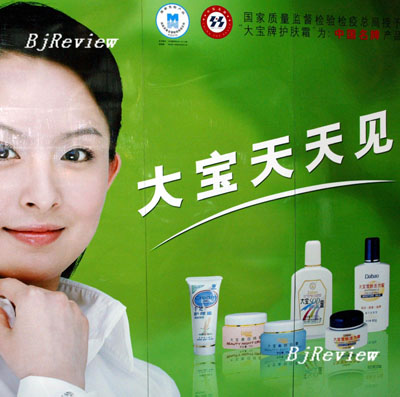
“Dabao, see you tomorrow.”
“Dabao, see you everyday.”
This catchphrase has made Dabao a household name. With this kind of brand awareness and over 20 years in the business, it’s no wonder China’s largest cosmetics manufacturer Beijing Dabao Cosmetics Co. Ltd. was a highly prized company. In April, Dabao completed an acquisition deal with Johnson & Johnson (J&J) in an effort to further elevate its brand performance and penetration.
The company put itself up for sale on February 27 by registering with the China Beijing Equity Exchange (CBEX), looking for a buyer to pay 2.3 billion for the company. In 2006, Dabao posted 676.2 million yuan of sales, with total assets of 645 million yuan, including 459.6 million yuan of net assets, according to a CBEX statement. However, the Beijing Ronghuajian Assets Evaluation Agency noted that Dabao had assets totaling 2.426 billion yuan, liabilities of 185.8 million yuan and equity of 2.24 billion yuan. Based on these figures, executives at Dabao decided the company was worth about 2.3 billion yuan.
Apart from its tangible assets, Dabao’s important intangibles include its deep brand penetration and far-reaching sales channels. Dabao has established nearly 350 counters in major shopping centers and over 3,000 in supermarkets and convenience stores nationwide.
On March 26, the sales bulletin was removed from the CBEX website, indicating Dabao had picked an intended bidder. Xinhua disclosed later that day that J&J and Dabao had signed an agreement for possible acquisition.
In 2004 the L’Oreal Group acquired Mini Nurse, and Colgate acquired Sanxiao, leaving Arche and a few national skin care brands to rival the foreign giants. The shampoo business had already been dominated by multinationals like Unilever and Procter&Gamble. Many Chinese began to worry that they would soon have no daily cosmetic brands of their own.
Pan Xiaoming, Chairman Assistant with the China Beauty & Cosmetics Chamber, was much more optimistic. “It only indicates that enterprises in this industry are combining their strengths,” Pan said. “The acquisitions are normal corporate activities, reducing the number of cosmetics manufacturers from over 5,000 two years ago to the present 3,300.”
Reaching its peak
Due to its catchy commercial slogans and economical prices, Dabao had been the dominating brand in China’s skin care market before foreign brands swarmed in.
Dabao used to be called Beijing Sanlu Factory, a state-owned social welfare enterprise. With only 7,000 yuan in its accounts, the factory couldn’t even pay its employees salaries in 1990. Determined to reform and innovate, the company’s new director Du Bin made radical changes in financing, research and development, as well as sales. As a result, Dabao introduced its most popular SOD Milk Cream in the same year.
Dabao became a household name after its advertisements first appeared on CCTV in 1993. Dabao has topped other brands of skin care products in terms of sales volume for eight consecutive years since 1997.
Beijing Sanlu Factory carried out shareholder reform in 2002, officially changing its name to Beijing Dabao Cosmetics Co. Ltd. After the reform, the state controlled 83 percent of its shares, with the remaining 17 percent resting in the hands of employees.
Like other major cosmetics companies in China, Dabao had reached its peak, however.
According to marketing expert Lai Shuiqin, Dabao fell short in terms of marketing and innovation. In recent years, Dabao’s annual sales volume hovered around 800 million yuan, while the domestic cosmetics industry overall grew by 20 percent. Other than the SOD Milk Cream, Dabao had no other new items.
| 